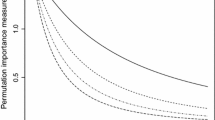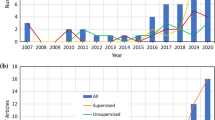Abstract
The integration of geological and geometallurgical data can significantly improve decision-making and optimize mining production due to a better understanding of the resources and their metallurgical performances. The primary-response rock property framework is an approach to the modelling of geometallurgy in which quantitative and qualitative primary properties are used as proxies of metallurgical responses. Within this framework, primary variables are used to fit regression models to predict metallurgical responses. Whilst primary rock property data are relatively abundant, metallurgical response property data are not, which makes it difficult to establish predictive response relationships. Relationships between primary input variables and geometallurgical responses are, in general, complex, and the response variables are often non-additive which further complicates the prediction process. Consequently, in many cases, the traditional multivariate linear regression models (MLR) of primary-response relationships perform poorly and a better alternative is required for prediction. Projection pursuit is a powerful exploratory statistical modelling technique in which data from a number of variables are projected onto a set of directions that optimize the fit of the model. The purpose of the projection is to reveal underlying relationships. Projection pursuit regression (PPR) fits standard regression models to the projected data vectors. In this paper, PPR is applied to the modelling of geometallurgical response variables. A case study with six geometallurgical variables is used to demonstrate the modelling approach. The results from the proposed PPR models show a significant improvement over those from MLR models. In addition, the models were bootstrapped to generate distributions of feasible scenarios for the response variables. Our results show that PPR is a robust technique for modelling geometallurgical response variables and for assessing the uncertainty associated with these variables.






Similar content being viewed by others
References
Amankwah H, Larsson T, Textorius B (2013) Open-Pit mining with uncertainty: a conditional value-at-risk approach. In: Migdalas A, Sifaleras A, Georgiadis CK et al (eds) Mathematics & statistics. Springer, New York, pp 117–139
Arlot S, Celisse A (2010) A survey of cross-validation procedures for model selection. Stat Surv 4:40–79. doi:10.1214/09-SS054
Armstrong M, Galli A (2011) A new approach to flexible open pit optimisation. Appl Comput Oper Res Miner Ind 24–30
Barnett RM, Manchuk JG, Deutsch CV (2013) Projection pursuit multivariate transform. Math Geosci 46:337–359. doi:10.1007/s11004-013-9497-7
Boisvert JB, Rossi ME, Ehrig K, Deutsch C (2013) Geometallurgical modeling at Olympic dam mine, South Australia. Math Geosci 45:901–925. doi:10.1007/s11004-013-9462-5
Carrasco P, Chiles J-P, Seguret S (2008) Additivity, metallurgical recovery, and grade. In: 8th international geostatistics congress, Santiago
Chatterjee S, Hadi AS (2015) Regression analysis by example. Wiley, New York
Coward S, Dowd PA (2015) Geometallurgical models for the quantification of uncertainty in mining project value chains. In: 37th APCOM conference, Society of Mining, Metallurgy and Exploration (SME) (ISBN 978-0-87335-417-2), pp 360–369
Coward S, Vann J, Dunham S, Stewart M (2009) The primary-response framework for geometallurgical variables. In: Seventh international mining geology conference, pp 109–113
Coward S, Dowd PA, Vann J (2013) Value chain modelling to evaluate geometallurgical recovery factors. In: 36th APCOM conference, Fundação Luiz Englert, Brazil (ISBN 978-85-61155-02-5), Porto Alegre, pp 288–289
Dowd PA, Xu C, Coward S (2015) Strategic mine planning and design: some challenges and strategies for addressing them. Min Technol 1743286315Y:000. doi:10.1179/1743286315Y.0000000032
Dunham S, Vann J (2007) Geometallurgy, geostatistics and project value—does your block model tell you what you need to know? In: Project evaluation conference, Melbourne, pp 189–196
Efron B, Gong G (1983) A leisurely look at the bootstrap, the jackknife, and cross-validation. Am Stat 37:36–48. doi:10.2307/2685844
Emery X, Silva D (2009) Conditional co-simulation of continuous and categorical variables for geostatistical applications. Comput Geosci 35:1234–1246. doi:10.1016/j.cageo.2008.07.005
Friedman JH (1984) A variable span smoother. Department of Statistics, Stanford University, Stanford
Friedman JH (1994) From statistics to neural networks: theory and pattern recognition applications. In: Cherkassky V, Friedman JH, Wechsler H (eds) Springer, Berlin, pp 1–61
Friedman JH, Stuetzle W (1981) Regression pursuit projection. J Am Stat Assoc 76:817–823
Friedman JH, Tukey JW (1974) A projection pursuit algorithm for exploratory data analysis. IEEE Trans Comput C-23:881–890
Friedman JH, Stuetzle W, Schroeder A (1984) Projection pursuit density estimation. J Am Stat Assoc 79:599–608
Ghasemi JB, Zolfonoun E (2013) Simultaneous spectrophotometric determination of trace amount of polycyclic aromatic hydrocarbons in water samples after magnetic solid-phase extraction by using projection pursuit regression. Environ Monit Assess 185:2297–305. doi:10.1007/s10661-012-2709-7
Glover F (1990) Tabu search: a tutorial 1990:74–94
Goulard M, Voltz M (1992) Linear coregionalization model: tools for estimation and choice of cross-variogram matrix. Math Geol 24:269–286. doi:10.1007/BF00893750
Hunt J, Kojovic T, Berry R (2013) Estimating comminution indices from ore mineralogy, chemistry and drill core logging. In: The second AusIMM international geometallurgy conference, Brisbane, pp 173–176
Hunt J, Berry R, Bradshaw D et al (2014) Development of recovery domains: examples from the Prominent Hill IOCG deposit, Australia. Miner Eng 64:7–14. doi:10.1016/j.mineng.2014.03.014
Keeney L, Walters SG (2011) A methodology for geometallurgical mapping and orebody modelling. In: The first AusIMM international geometallurgy conference, Brisbane, pp 217–225
Kumral M (2013) Optimizing ore-waste discrimination and block sequencing through simulated annealing. Appl Soft Comput 13:3737–3744. doi:10.1016/j.asoc.2013.03.005
Lagos G, Espinoza D, Moreno E, Amaya J (2011) Robust planning for an open-pit mining problem under ore-grade uncertainty. Electron Notes Discret Math 37:15–20. doi:10.1016/j.endm.2011.05.004
Lee E, Cook D, Klinke S, Lumley T (2005) Projection pursuit for exploratory supervised classification. J Comput Graph Stat 14:831–846. doi:10.1198/106186005X77702
Lutz S, Hickman S, Davatzes N (2010) Rock mechanical testing and petrologic analysis in support of well stimulation activities at the Desert Peak Geothermal Field, Nevada. In: 35th workshop on geothermal reservoir engineering
Maleki M, Emery X (2014) Joint simulation of grade and rock type in a stratabound copper deposit. Math Geosci 1–25. doi:10.1007/s11004-014-9556-8
Marcotte D, Caron J (2013) Ultimate open pit stochastic optimization. Comput Geosci 51:238–246. doi:10.1016/j.cageo.2012.08.008
Qianjian G, Jianguo Y (2010) Application of projection pursuit regression to thermal error modeling of a CNC machine tool. Int J Adv Manuf Technol 55:623–629. doi:10.1007/s00170-010-3114-4
Ramazan S, Dimitrakopoulos R (2012) Production scheduling with uncertain supply: a new solution to the open pit mining problem. Optim Eng 14:361–380. doi:10.1007/s11081-012-9186-2
Silverman BW (1984) Spline smoothing: the equivalent variable kernel method. Ann Stat 12:898–916
Walters SG (2008) An overview of new integrated geometallurgical research. In: Ninth international congress for applied mineralogy, Brisbane, pp 8–10
Weisberg S (2005) Applied linear regression. Wiley, New York
Xu C, Dowd PA (2009) Conditional simulation of grades controlled by geological indicators. In: Dimitrakopoulos R (eds) Modelling orebody, mine strategic. Planning, Perth, pp 43–49
Author information
Authors and Affiliations
Corresponding author
Rights and permissions
About this article
Cite this article
Sepulveda, E., Dowd, P.A., Xu, C. et al. Multivariate Modelling of Geometallurgical Variables by Projection Pursuit. Math Geosci 49, 121–143 (2017). https://doi.org/10.1007/s11004-016-9660-z
Received:
Accepted:
Published:
Issue Date:
DOI: https://doi.org/10.1007/s11004-016-9660-z




